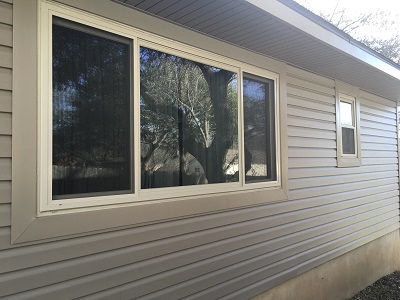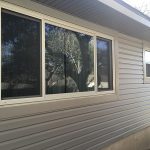
In Exploring Windows-Part I, I discussed some of the energy efficient benefits of replacing your windows. Today, I’m going to discuss the two G’s in windows: glass & gas.
Energy Efficient Glass
The ability of a material to be able to emit energy by radiation is emissivity. Hey, I don’t make these words up! In layman’s terms, a material that is reflective will have a lower emissivity than a material that isn’t reflective. Think of a white shirt on hot day, or a black shirt on cold day.
When it comes to replacement windows, I’m sure you’ve seen some that have a bit of a tint to the glass. The individual panes are coated with a reflective (or low-emissivity) material, such as silver or aluminum. Generically, these are called “Low-E”. The Low-E helps block UV rays from entering your home. Notice how your drapes or couch is faded where the sunlight hits it? Low-E will help reduce that for you!
If you’ve ever walked by a building on a sunny day, and felt the heat reflecting back at you, then you’ve experienced one of the benefits of Low-E.
There are various degrees of Low-E though, each with a different level of emissivity. When researching a particular window line to order, you may want to look for what options are available in the manufacturer’s glass packages.
Going back to what I mentioned about some windows looking like they have tint, some homeowners prefer to have windows that allow as much natural light in. For those clients, we can order windows without Low-E. I just always have to make sure that it is understood that these windows are no very energy efficient.
Gas? For My Windows?
When shopping for new windows, you will need to consider the type of gas that’s between the panes. Why is that?
The gas between the panes will help to reduce the amount of heat transferring through the panes, and into your home. You have a few choices that I’ve listed below.
At one end of the spectrum, we have air. Air is the least efficient of all gases for a window. On occasion, if someone is wanting to cut corners, I will have these requests. Very few manufacturers are even offering this as an option these days. If you have a salesman who tries to promote “air” as an energy efficient gas, don’t even bother taking a bid from them.
Argon gas is the most common for my clients. Argon is 6 times as dense as air, which means it resists heat transferring through the panes of glass much better. The vast majority of replacement windows use argon gas.
At the other end of the spectrum, we have krypton. Krypton is even more dense than argon (about twice as dense)! However, the cost of krypton at this point is astronomical, which puts it out of the realm of possibility for most homeowners. We’re looking to recoup what we spend, right?
I know this post was a bit jargon heavy. Next article, I will take it easy, and focus on the different materials used for window frames.
Until next time,
Travis Diekmann
The Texan Roofer


 Previous Post
Previous Post